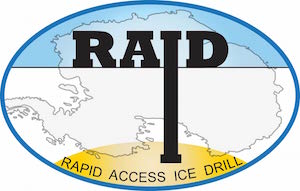We haven’t posted for a while, but – you know – Covid-19. Our RAID science and drilling team got off the ice in February of 2020 and headed home just as the news was hitting of a ‘mysterious coronavirus’ popping up in various parts of the world. I remember walking through the Auckland airport, still trying to adjust to life in the normal world without snow and ice, wondering how serious a problem this would be. Little did I, or anyone else, understand.
Fast forward, it’s now late in 2022. The worst of the pandemic is hopefully behind us. And there is good news. Starting a couple of months ago, the US Antarctic Program got a new field season underway after a 2-year hiatus. So field science is underway again in Antarctica!
During the past two and half years, RAID had to stand down, as did nearly all US science projects. So, our hope – our plan – to roll right from successful field testing to traversing up onto the high Polar Plateau and transitioning into science drilling did not come to pass. Like so many other science teams, we were forced to sit tight and hope for the best when there was little idea how things would play out during the pandemic.
In the meantime, however, we got so lucky! NSF granted our request to bring the Fluid Recirculation System module back to the US for a retrofit and upgrade, based on our experience gained during the last field trials. Even in the face of adversity, a great benefit of field trials is that they lead you to generate a lot of ideas for how to do things better. The RAID system was designed and built before taking it to the ice, based on our collective knowledge of drilling systems and working in the polar environment. But because a system like this for drilling in Antarctica hadn’t yet been attempted, we were building somewhat on faith. The field trials at Minna Bluff gave us both encouragement and steady doses of reality. Fundamentally, the system works, but we thought the best way to implement new ideas was to bring it home.
We expected that the FRS would be loaded onto the resupply vessel for the annual ‘retro’ trip back to the US. We were floored, however, to learn that after picking the module from its skis with a crane, the Air Force was willing – and had lots of room – to load the container into a northbound C-17 Globemaster!

Cargo personnel load the FRS module onto a U.S. Air Force C-17 at Phoenix Airfield near McMurdo. Photo courtesy of Lee Smith.
Seeing the heart of RAID sliding into the throat of a C-17 is an amazing sight, even in photographs. It must have been something to see in person. This was a huge break for us because that little lift to New Zealand would shave quite a bit of time on the trip home. Huge thanks are due to the cargo staff in McMurdo and the aircraft crew for making this happen! Little did we know that from Christchurch, the USAF would carry the FRS quite a bit farther – with a long flight all the way to Joint Base Lewis-McChord in Washington state! What would normally have taken weeks by ship was short-circuited to a matter of hours.

The FRS module arrives in Christchurch, New Zealand, before eventually being airlifted onward to Joint Base Lewis-McChord, in Washington state, and then put on a truck to Lewisburg, Tennessee.
From Washington, our FRS module and other air cargo were trucked down to Port Hueneme in southern California, and from there it was shipped by truck freight to Lewisburg, Tennessee, home to Matrix Drilling Products.

Here’s something you don’t see every day – the FRS sitting on green grass! Photo courtesy of Chris Delahunty.
Matrix is an industry leader in the design and manufacture of specialty drilling equipment. Not coincidentally, the company is now headed by Chris Delahunty, who was the principal engineer of the RAID system in its infancy. RAID has partnered with Matrix to make a top-to-bottom evaluation of the centrally important FRS module and to carry out the necessary design, fabrication, and testing of critical components.
Chris and his team at Matrix are charged with designing, building and retrofitting improvements to the FRS, including tank sight glasses, an improved ventilation system, a better ice melting system, optimized above-ground and down-hole pieces of the drilling system, a more robust automation system, a more efficient and true way to mate the Drill and Rod modules in the field, and many other upgrades.
In our next posts, we’ll share some examples of what’s been going on with RAID back in the US.
Photos by John Goodge, unless otherwise noted.
The views expressed here are personal reflections that do not represent either the RAID project or the National Science Foundation.
